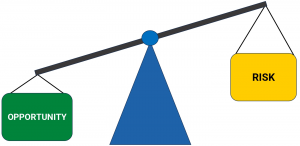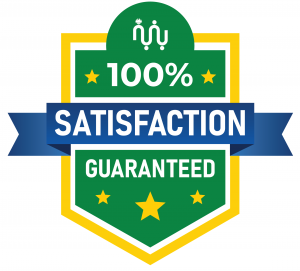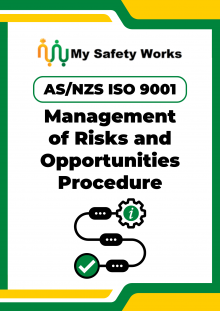Description
What is Risk and Opportunity Management?
Risk and opportunity management is the proactive identification, assessment, and mitigation or exploitation of risks and opportunities. It is a continuous process that should be incorporated into an organization’s overall strategic planning and day-to-day operations.
Risk and opportunity management can help organizations achieve their objectives by:
- Proactively identifying and assessing opportunities and risks based on AS/NZS ISO 9001 2016 quality management principles.
- Mitigating and exploiting risks and opportunities.
- Incorporating risk and opportunity management into overall strategic planning and day-to-day operations
By identifying and responding to risks and opportunities, businesses can protect themselves from potential threats and take advantage of growth opportunities.
By identifying and responding to opportunities and risks, businesses can take advantage of growth opportunities and protect themselves from potential threats.

What are Risks and Opportunities?
In basic terms:
- A risk is the likelihood of a negative effect.
- Risk assessment is the overall process of risk identification, risk analysis and risk evaluation.
- An opportunity is the positive effect of uncertainty.
How Do You Identify Risks and Opportunities?
There are many ways to identify risks and opportunities. The key is to think creatively and be open to different possibilities. For any business, the identification of risks and opportunities is a critical activity at both the strategic and operational levels.
It needs to include all significant sources of risk, including those beyond the business’s control. Quite simply, if a risk, threat or opportunity is not identified, there can be no strategy to manage it.
The key objective of the identification step is not to create a difficult and lengthy list of all possible risks, but to identify all significant risks that could impact the business.
Opportunities and risks can be identified by:
- Workshop and focus group meetings (to brainstorm ideas or do business and market analyses).
- Discussions with (internal and external) interested parties and stakeholders.
- Industry, market, supply chains and uncertain events research.
- Conducting risk management reviews of positive and negative impacts and aspects.
- Observation and consultation with personnel conducting their general work tasks.
Once identified, opportunities and risks should be recorded as part of the ‘context of the organization.’
How to Manage Risks and Opportunities?
The best way to manage risks and opportunities is to be proactive. Some risks can be easy to manage and will present an opportunity for your business to grow. Others will be more difficult to manage and could present a serious threat to your business.
An organization’s approach to managing risks and opportunities will vary depending on the size and type of business, the products or services it provides, and the sector in which it operates.
As mentioned, the most effective approach to managing opportunities and risks is to adopt a systematic and proactive approach, and this should be embedded into the culture of the business. One of the best ways to manage or reduce risks is to have an effective documented procedure in place to follow.
The overall aim of opportunity and risk management is to ensure that capabilities and resources are engaged in a manner to mitigate risks and take advantage of opportunities. Similarly, if you can identify opportunities and take advantage of them before your competitors you will be ahead of the ‘game.’
Contents of this AS/NZS ISO 9001 Management of Risks and Opportunities Procedure
- Approval.
- Purpose.
- Scope.
- Terms and Definitions.
- Roles and Responsibilities.
- Procedures.
- Risk and Opportunity Management Process Overview.
- Risks and Opportunities Process Activity Map.
- Management of Risks.
- Identification.
- Risk Assessment.
- Risk Control.
- Management of Opportunities.
- Monitor and Review.
- Reporting.
- Communication.
- Training.
- Related Procedures, Forms and Documents.
- Review Criteria.
- Record Management.
- References.
Why Choose to Buy this AS/NZS ISO 9001 Management of Risks and Opportunities Procedure
This 11-page AS/NZS ISO 9001 management of risks and opportunities procedure can assist you document the risk and opportunity processes, so you can:
- Consider all types of risks and opportunities, specifically those associated with the quality management system (QMS).
- Ensure the systematic identification and assessment of opportunities and risks so that objectives and desired outcomes can be achieved.
- Ensure that resources are provided to enable the management of opportunities and risks.
- Assist you with the maintenance of a risk and opportunity register (if used) for the scope and objectives.
- Support compliance to the AS/NZS ISO 9001 standard regarding a process approach to opportunities and risks and achieve certification.
After purchasing this procedure you will be able to:
- Very easily edit and customize the template to create your own management of risks and opportunities procedure.
- Apply your own style, format and brand to the procedure.
- Use it in any industry or sector regardless of the size or type of organization.
Availability and Use of this AS/NZS ISO 9001 Management of Risks and Opportunities Procedure
- This procedure is accessible to you right now by clicking the ‘Buy Now’ button.
- The procedure will be delivered to you in fully editable Microsoft Word format for immediate and full use in your business.
- There are no subscriptions, contracts or ongoing costs.

This AS/NZS ISO 9001 management of risks and opportunities procedure is 100% satisfaction guaranteed.
You may also require:


